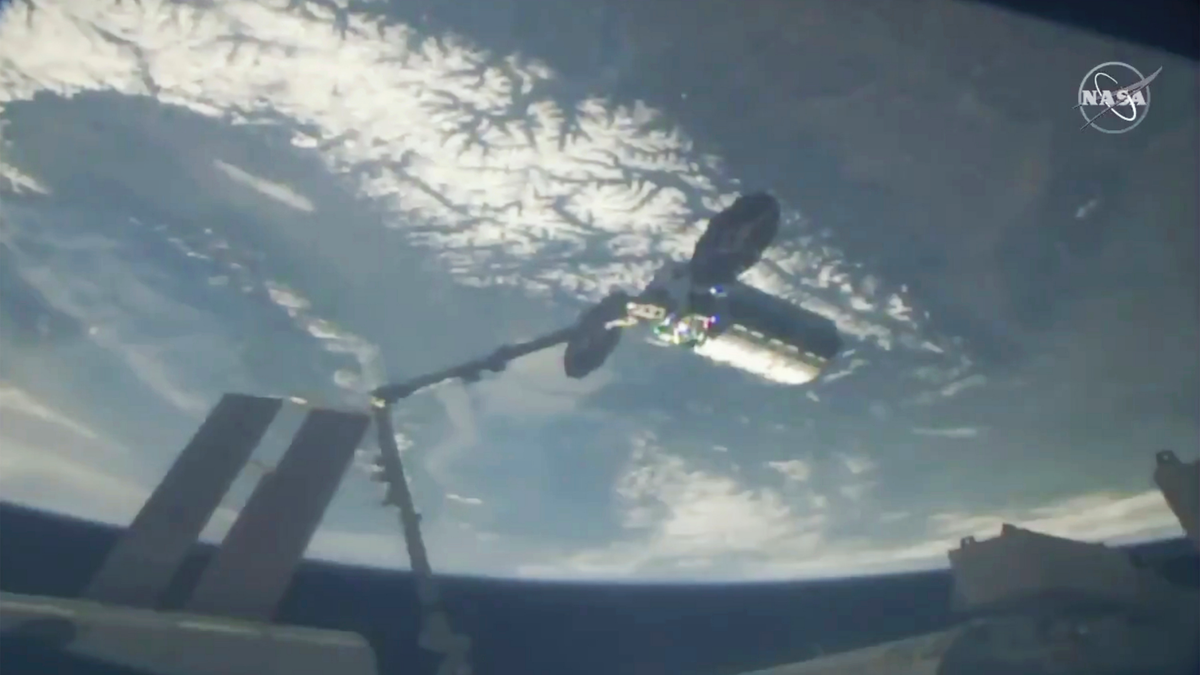
This photo provided by NASA shows a cargo ship arriving at the International Space Station, Friday, April 19, 2019. Space station astronaut Anne McClain used a robot arm to capture Northrop Grumman’s Cygnus capsule as they soared 258 miles (415 kilometers) above France. The Cygnus and its 7,600-pound (3,450-kilogram) shipment rocketed from Wallops Island, Va., on Wednesday, completing the trip in short order. (NASA via AP)
NASA plans to allow tourists to visit the International Space Station from 2020 – at an estimated cost of more than $50 million (£39 million) per trip.
Until now, the floating space lab has only been accessible to astronauts representing state-level space agencies.
In a surprise announcement today, NASA confirmed that it would be "opening the International Space Station for commercial business".
It means that private companies will be able to take "private astronauts" to the ISS for up to 30 days.
"The agency can accommodate up to two short-duration private astronaut missions per year to the International Space Station," Nasa explained.
"These missions will be privately funded, dedicated commercial spaceflights."
Transport will be provided by both Boeing and Elon Musk's SpaceX, who are currently developing capsules that can carry humans to the ISS.
It's expected that a trip will likely cost around $50 million (£39 million) per astronaut, according to early estimates – but could easily rise well above that figure.
The spaceflight to the ISS will account for a large chunk of the cost.
NASA typically pays around $75 million for seats aboard a Soyuz spacecraft destined for the ISS, and even paid $82 million per seat in 2015.
However, NASA says seats aboard the SpaceX Crew Dragon and/or Boeing CST-100 capsules will cost roughly $58 million per seat.
It's these capsules that will be used to ferry astronauts up to the ISS – but the cost continues to rise after the journey.
Keeping astronauts on board the ISS is a pricey business.
For instance, regenerative life support and toilet cost $11,250 (£8,800) per astronaut each day.
And general supplies – like food and air – cost $22,500 (£17,500) per astronaut each day.
Nasa will get around $35,000 (£27,000) per night that a private astronaut spends on board the ISS.
A large bank balance won't be enough either: you'll have to pass Nasa's rigorous health checks and training procedures.
As part of its "commercialization" of the ISS, Nasa will be making one space station port and utilities available for a private company to "attach a commercial module to".
And it hopes that in the long-term, there will be lots of private space stations floating just above Earth.
"In the long-term, NASA’s goal is to become one of many customers purchasing services from independent, commercial and free-flying habitable destinations in low-Earth orbit," NASA explained.
"A robust low-Earth orbit economy will need multiple commercial destinations, and NASA is partnering with industry to pursue dual paths to that objective that either go through the space station or directly to a free-flying destination."
Whatever ends up going into space, it's unlikely to get cheaper any time soon.
Even SpaceX charges $62million (£48.7million) to send commercial satellites into orbit with its relatively new Falcon 9 rocket.
And Axiom Space, a Houston-based company hoping to organize trips to the ISS, has pledged to charge $55 million (£43.2 million) for a 10-day trip to the ISS.
So why is NASA letting tourists travel to the ISS?
The main advantage seems to be keeping costs down, as the ISS is very expensive to run.
But it's also about continuing to test space travel – to make it safer and cheaper for everyone.
"Market studies identified private astronaut missions to low-Earth orbit as a key element to demonstrate demand and reduce risk for future commercial destinations in low-Earth orbit," NASA explained.
The long-term plan is to create space stations near Earth that can be used as stop-off points for deeper trips into space.
NASA hopes to set up several "lunar gateways" starting from 2028 that will float near the Moon, and could be used for crewed missions to Mars.
"The first Gateway is about the moon, but I think the second Gateway, being a deep-space transport, again using commercial and international partners, enables us to get to Mars," said NASA top boss Jim Bridenstine, speaking last year.
"What we don’t want to do is go to the surface of the moon, prove that we can do it again, and then be done. We want to go to stay.
"And the Gateway, in my view – I’ve been convinced – enables us to take advantage of commercial and international partners in a more robust way so we are there to stay, it enables us to get to more parts of the moon than ever before, and it enables us to get to Mars."
This story originally appeared in The Sun.



















